Medical System Errors: A Case Study Analysis of Patient Zoya
VerifiedAdded on 2023/06/04
|12
|3822
|362
AI Summary
This case study report analyzes the medical system errors in the treatment of Patient Zoya for an ear infection. It discusses issues related to computerized medical practice, continuity of care, and patient safety. The report offers recommendations for improving patient safety and reducing medical errors.
Contribute Materials
Your contribution can guide someone’s learning journey. Share your
documents today.
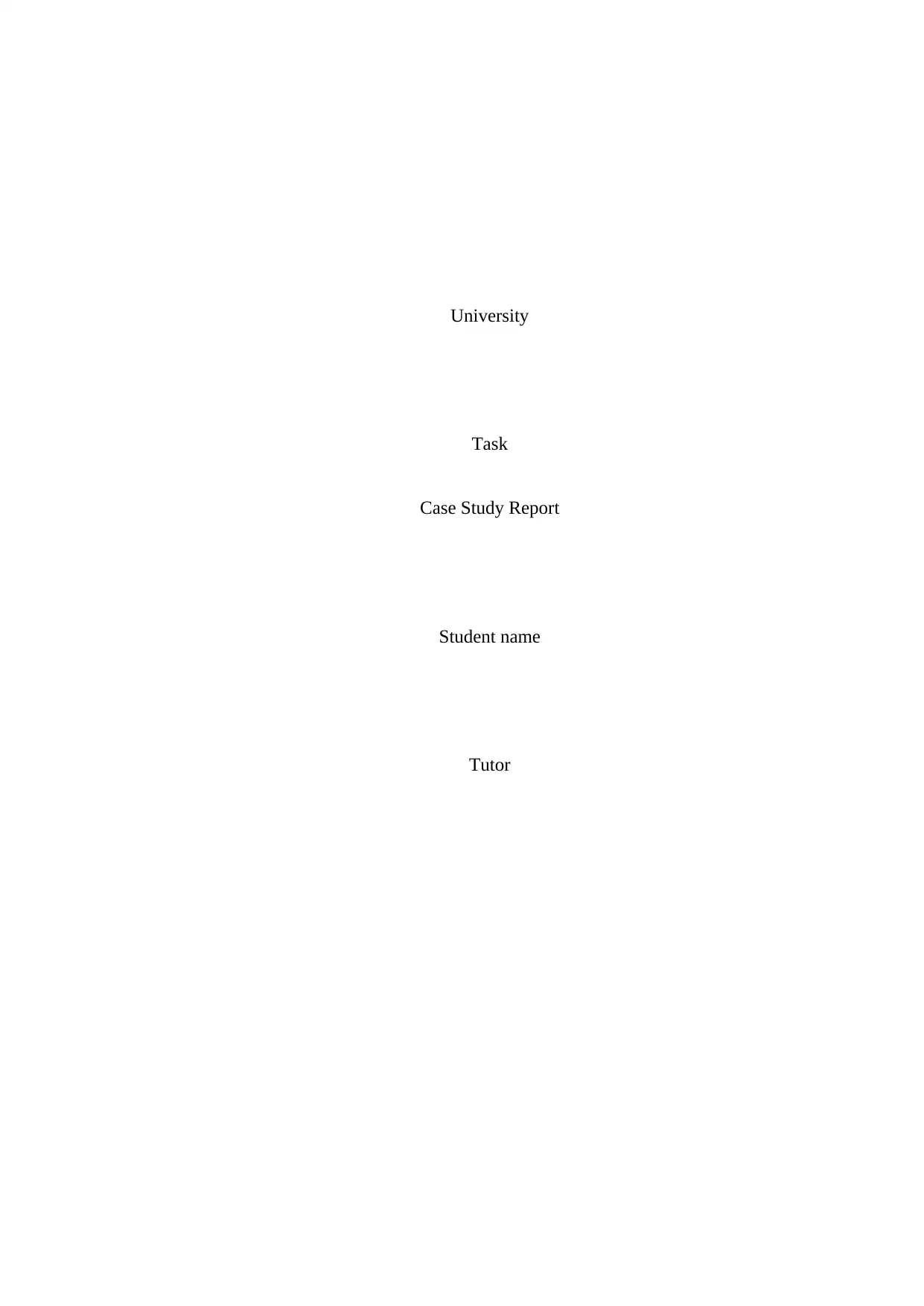
University
Task
Case Study Report
Student name
Tutor
Task
Case Study Report
Student name
Tutor
Secure Best Marks with AI Grader
Need help grading? Try our AI Grader for instant feedback on your assignments.
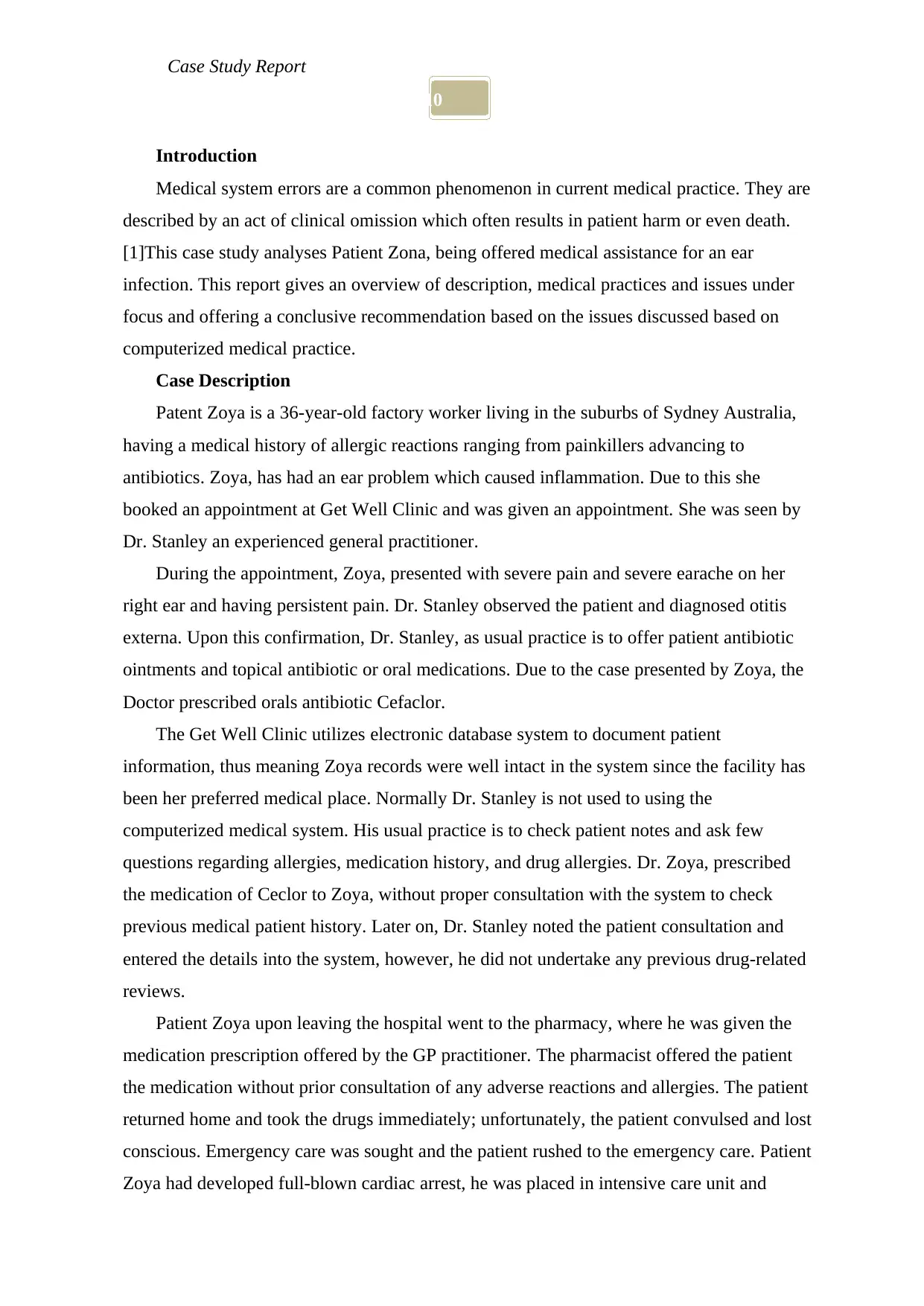
10
Case Study Report
Introduction
Medical system errors are a common phenomenon in current medical practice. They are
described by an act of clinical omission which often results in patient harm or even death.
[1]This case study analyses Patient Zona, being offered medical assistance for an ear
infection. This report gives an overview of description, medical practices and issues under
focus and offering a conclusive recommendation based on the issues discussed based on
computerized medical practice.
Case Description
Patent Zoya is a 36-year-old factory worker living in the suburbs of Sydney Australia,
having a medical history of allergic reactions ranging from painkillers advancing to
antibiotics. Zoya, has had an ear problem which caused inflammation. Due to this she
booked an appointment at Get Well Clinic and was given an appointment. She was seen by
Dr. Stanley an experienced general practitioner.
During the appointment, Zoya, presented with severe pain and severe earache on her
right ear and having persistent pain. Dr. Stanley observed the patient and diagnosed otitis
externa. Upon this confirmation, Dr. Stanley, as usual practice is to offer patient antibiotic
ointments and topical antibiotic or oral medications. Due to the case presented by Zoya, the
Doctor prescribed orals antibiotic Cefaclor.
The Get Well Clinic utilizes electronic database system to document patient
information, thus meaning Zoya records were well intact in the system since the facility has
been her preferred medical place. Normally Dr. Stanley is not used to using the
computerized medical system. His usual practice is to check patient notes and ask few
questions regarding allergies, medication history, and drug allergies. Dr. Zoya, prescribed
the medication of Ceclor to Zoya, without proper consultation with the system to check
previous medical patient history. Later on, Dr. Stanley noted the patient consultation and
entered the details into the system, however, he did not undertake any previous drug-related
reviews.
Patient Zoya upon leaving the hospital went to the pharmacy, where he was given the
medication prescription offered by the GP practitioner. The pharmacist offered the patient
the medication without prior consultation of any adverse reactions and allergies. The patient
returned home and took the drugs immediately; unfortunately, the patient convulsed and lost
conscious. Emergency care was sought and the patient rushed to the emergency care. Patient
Zoya had developed full-blown cardiac arrest, he was placed in intensive care unit and
Case Study Report
Introduction
Medical system errors are a common phenomenon in current medical practice. They are
described by an act of clinical omission which often results in patient harm or even death.
[1]This case study analyses Patient Zona, being offered medical assistance for an ear
infection. This report gives an overview of description, medical practices and issues under
focus and offering a conclusive recommendation based on the issues discussed based on
computerized medical practice.
Case Description
Patent Zoya is a 36-year-old factory worker living in the suburbs of Sydney Australia,
having a medical history of allergic reactions ranging from painkillers advancing to
antibiotics. Zoya, has had an ear problem which caused inflammation. Due to this she
booked an appointment at Get Well Clinic and was given an appointment. She was seen by
Dr. Stanley an experienced general practitioner.
During the appointment, Zoya, presented with severe pain and severe earache on her
right ear and having persistent pain. Dr. Stanley observed the patient and diagnosed otitis
externa. Upon this confirmation, Dr. Stanley, as usual practice is to offer patient antibiotic
ointments and topical antibiotic or oral medications. Due to the case presented by Zoya, the
Doctor prescribed orals antibiotic Cefaclor.
The Get Well Clinic utilizes electronic database system to document patient
information, thus meaning Zoya records were well intact in the system since the facility has
been her preferred medical place. Normally Dr. Stanley is not used to using the
computerized medical system. His usual practice is to check patient notes and ask few
questions regarding allergies, medication history, and drug allergies. Dr. Zoya, prescribed
the medication of Ceclor to Zoya, without proper consultation with the system to check
previous medical patient history. Later on, Dr. Stanley noted the patient consultation and
entered the details into the system, however, he did not undertake any previous drug-related
reviews.
Patient Zoya upon leaving the hospital went to the pharmacy, where he was given the
medication prescription offered by the GP practitioner. The pharmacist offered the patient
the medication without prior consultation of any adverse reactions and allergies. The patient
returned home and took the drugs immediately; unfortunately, the patient convulsed and lost
conscious. Emergency care was sought and the patient rushed to the emergency care. Patient
Zoya had developed full-blown cardiac arrest, he was placed in intensive care unit and
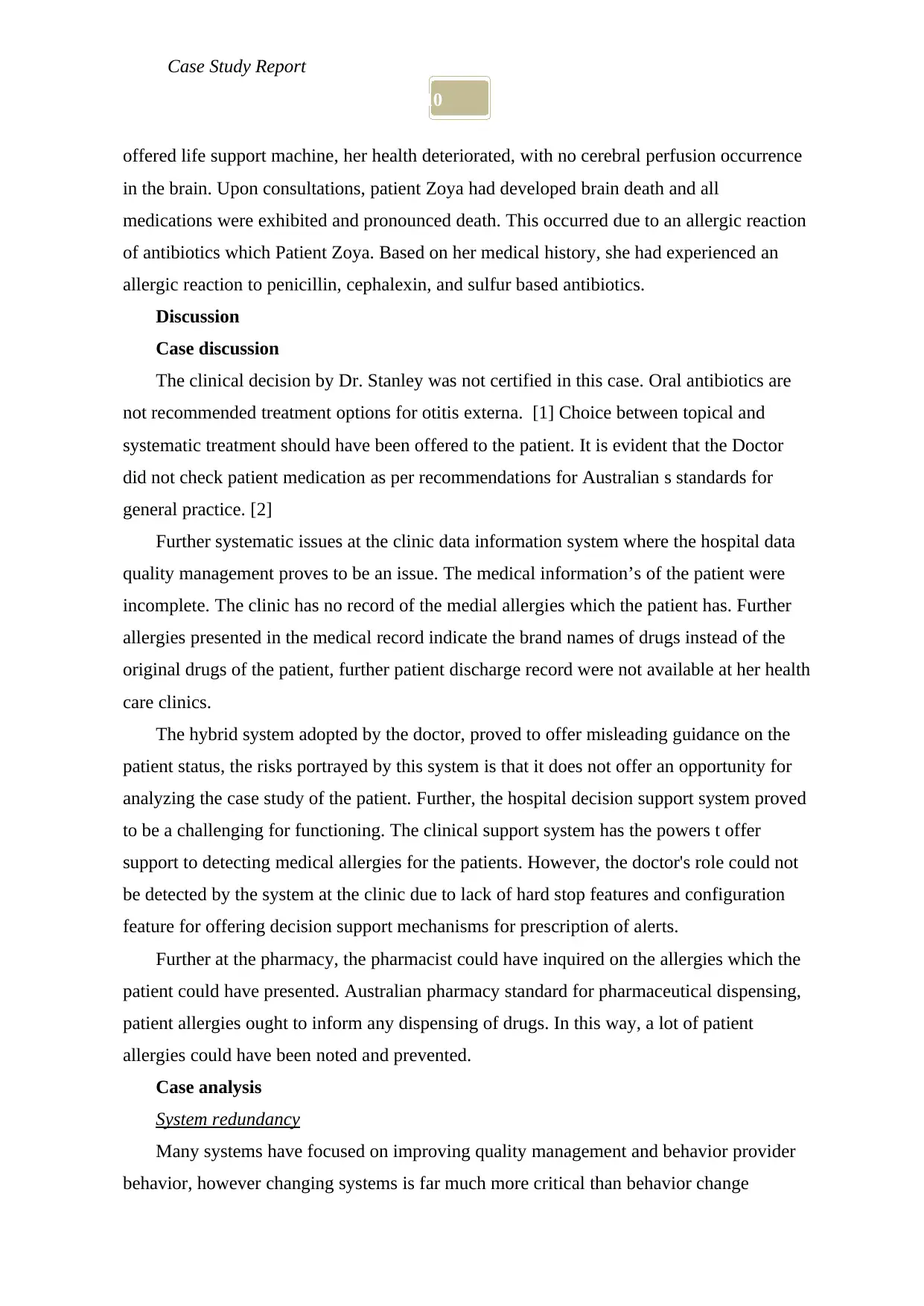
10
Case Study Report
offered life support machine, her health deteriorated, with no cerebral perfusion occurrence
in the brain. Upon consultations, patient Zoya had developed brain death and all
medications were exhibited and pronounced death. This occurred due to an allergic reaction
of antibiotics which Patient Zoya. Based on her medical history, she had experienced an
allergic reaction to penicillin, cephalexin, and sulfur based antibiotics.
Discussion
Case discussion
The clinical decision by Dr. Stanley was not certified in this case. Oral antibiotics are
not recommended treatment options for otitis externa. [1] Choice between topical and
systematic treatment should have been offered to the patient. It is evident that the Doctor
did not check patient medication as per recommendations for Australian s standards for
general practice. [2]
Further systematic issues at the clinic data information system where the hospital data
quality management proves to be an issue. The medical information’s of the patient were
incomplete. The clinic has no record of the medial allergies which the patient has. Further
allergies presented in the medical record indicate the brand names of drugs instead of the
original drugs of the patient, further patient discharge record were not available at her health
care clinics.
The hybrid system adopted by the doctor, proved to offer misleading guidance on the
patient status, the risks portrayed by this system is that it does not offer an opportunity for
analyzing the case study of the patient. Further, the hospital decision support system proved
to be a challenging for functioning. The clinical support system has the powers t offer
support to detecting medical allergies for the patients. However, the doctor's role could not
be detected by the system at the clinic due to lack of hard stop features and configuration
feature for offering decision support mechanisms for prescription of alerts.
Further at the pharmacy, the pharmacist could have inquired on the allergies which the
patient could have presented. Australian pharmacy standard for pharmaceutical dispensing,
patient allergies ought to inform any dispensing of drugs. In this way, a lot of patient
allergies could have been noted and prevented.
Case analysis
System redundancy
Many systems have focused on improving quality management and behavior provider
behavior, however changing systems is far much more critical than behavior change
Case Study Report
offered life support machine, her health deteriorated, with no cerebral perfusion occurrence
in the brain. Upon consultations, patient Zoya had developed brain death and all
medications were exhibited and pronounced death. This occurred due to an allergic reaction
of antibiotics which Patient Zoya. Based on her medical history, she had experienced an
allergic reaction to penicillin, cephalexin, and sulfur based antibiotics.
Discussion
Case discussion
The clinical decision by Dr. Stanley was not certified in this case. Oral antibiotics are
not recommended treatment options for otitis externa. [1] Choice between topical and
systematic treatment should have been offered to the patient. It is evident that the Doctor
did not check patient medication as per recommendations for Australian s standards for
general practice. [2]
Further systematic issues at the clinic data information system where the hospital data
quality management proves to be an issue. The medical information’s of the patient were
incomplete. The clinic has no record of the medial allergies which the patient has. Further
allergies presented in the medical record indicate the brand names of drugs instead of the
original drugs of the patient, further patient discharge record were not available at her health
care clinics.
The hybrid system adopted by the doctor, proved to offer misleading guidance on the
patient status, the risks portrayed by this system is that it does not offer an opportunity for
analyzing the case study of the patient. Further, the hospital decision support system proved
to be a challenging for functioning. The clinical support system has the powers t offer
support to detecting medical allergies for the patients. However, the doctor's role could not
be detected by the system at the clinic due to lack of hard stop features and configuration
feature for offering decision support mechanisms for prescription of alerts.
Further at the pharmacy, the pharmacist could have inquired on the allergies which the
patient could have presented. Australian pharmacy standard for pharmaceutical dispensing,
patient allergies ought to inform any dispensing of drugs. In this way, a lot of patient
allergies could have been noted and prevented.
Case analysis
System redundancy
Many systems have focused on improving quality management and behavior provider
behavior, however changing systems is far much more critical than behavior change
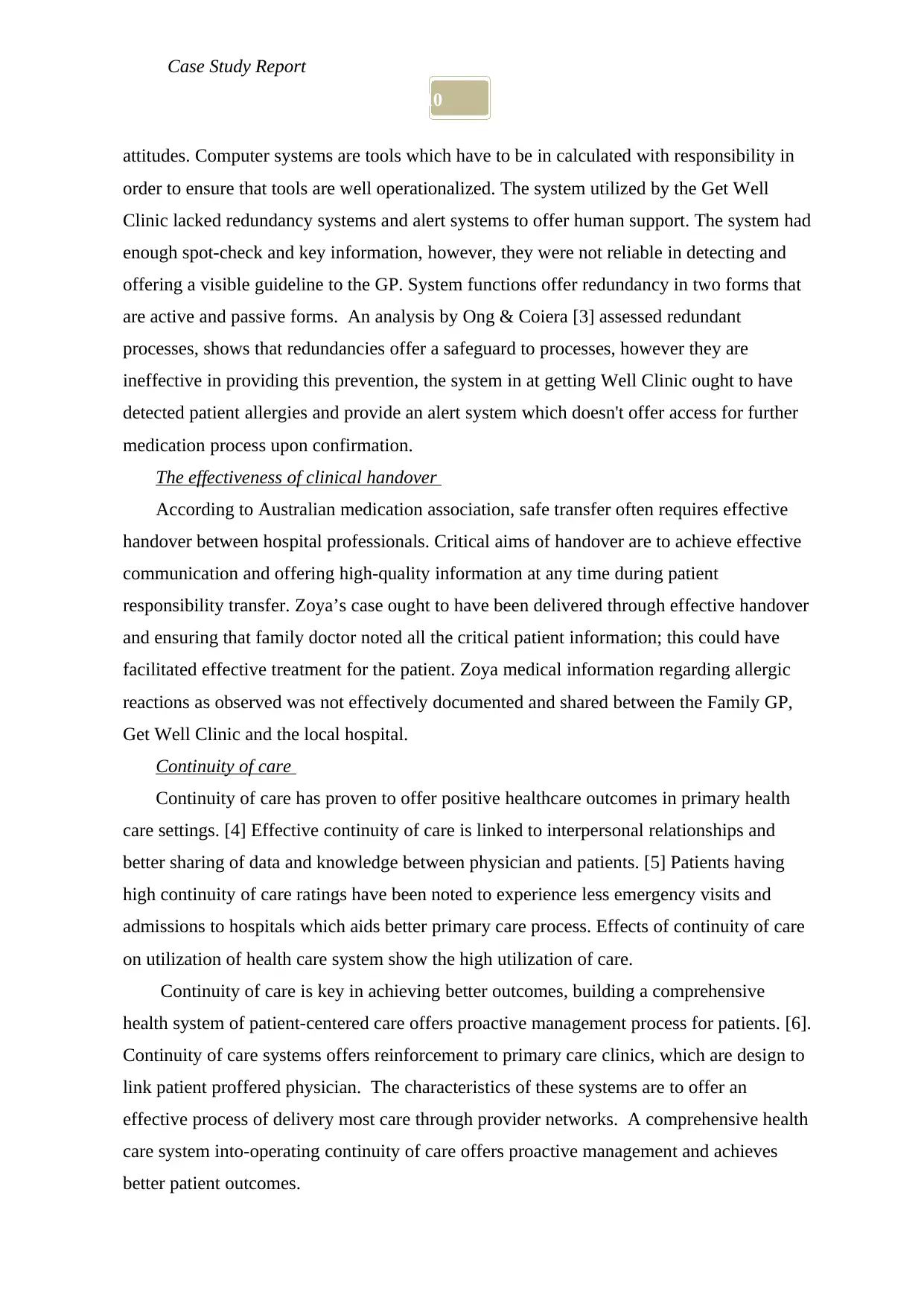
10
Case Study Report
attitudes. Computer systems are tools which have to be in calculated with responsibility in
order to ensure that tools are well operationalized. The system utilized by the Get Well
Clinic lacked redundancy systems and alert systems to offer human support. The system had
enough spot-check and key information, however, they were not reliable in detecting and
offering a visible guideline to the GP. System functions offer redundancy in two forms that
are active and passive forms. An analysis by Ong & Coiera [3] assessed redundant
processes, shows that redundancies offer a safeguard to processes, however they are
ineffective in providing this prevention, the system in at getting Well Clinic ought to have
detected patient allergies and provide an alert system which doesn't offer access for further
medication process upon confirmation.
The effectiveness of clinical handover
According to Australian medication association, safe transfer often requires effective
handover between hospital professionals. Critical aims of handover are to achieve effective
communication and offering high-quality information at any time during patient
responsibility transfer. Zoya’s case ought to have been delivered through effective handover
and ensuring that family doctor noted all the critical patient information; this could have
facilitated effective treatment for the patient. Zoya medical information regarding allergic
reactions as observed was not effectively documented and shared between the Family GP,
Get Well Clinic and the local hospital.
Continuity of care
Continuity of care has proven to offer positive healthcare outcomes in primary health
care settings. [4] Effective continuity of care is linked to interpersonal relationships and
better sharing of data and knowledge between physician and patients. [5] Patients having
high continuity of care ratings have been noted to experience less emergency visits and
admissions to hospitals which aids better primary care process. Effects of continuity of care
on utilization of health care system show the high utilization of care.
Continuity of care is key in achieving better outcomes, building a comprehensive
health system of patient-centered care offers proactive management process for patients. [6].
Continuity of care systems offers reinforcement to primary care clinics, which are design to
link patient proffered physician. The characteristics of these systems are to offer an
effective process of delivery most care through provider networks. A comprehensive health
care system into-operating continuity of care offers proactive management and achieves
better patient outcomes.
Case Study Report
attitudes. Computer systems are tools which have to be in calculated with responsibility in
order to ensure that tools are well operationalized. The system utilized by the Get Well
Clinic lacked redundancy systems and alert systems to offer human support. The system had
enough spot-check and key information, however, they were not reliable in detecting and
offering a visible guideline to the GP. System functions offer redundancy in two forms that
are active and passive forms. An analysis by Ong & Coiera [3] assessed redundant
processes, shows that redundancies offer a safeguard to processes, however they are
ineffective in providing this prevention, the system in at getting Well Clinic ought to have
detected patient allergies and provide an alert system which doesn't offer access for further
medication process upon confirmation.
The effectiveness of clinical handover
According to Australian medication association, safe transfer often requires effective
handover between hospital professionals. Critical aims of handover are to achieve effective
communication and offering high-quality information at any time during patient
responsibility transfer. Zoya’s case ought to have been delivered through effective handover
and ensuring that family doctor noted all the critical patient information; this could have
facilitated effective treatment for the patient. Zoya medical information regarding allergic
reactions as observed was not effectively documented and shared between the Family GP,
Get Well Clinic and the local hospital.
Continuity of care
Continuity of care has proven to offer positive healthcare outcomes in primary health
care settings. [4] Effective continuity of care is linked to interpersonal relationships and
better sharing of data and knowledge between physician and patients. [5] Patients having
high continuity of care ratings have been noted to experience less emergency visits and
admissions to hospitals which aids better primary care process. Effects of continuity of care
on utilization of health care system show the high utilization of care.
Continuity of care is key in achieving better outcomes, building a comprehensive
health system of patient-centered care offers proactive management process for patients. [6].
Continuity of care systems offers reinforcement to primary care clinics, which are design to
link patient proffered physician. The characteristics of these systems are to offer an
effective process of delivery most care through provider networks. A comprehensive health
care system into-operating continuity of care offers proactive management and achieves
better patient outcomes.
Secure Best Marks with AI Grader
Need help grading? Try our AI Grader for instant feedback on your assignments.
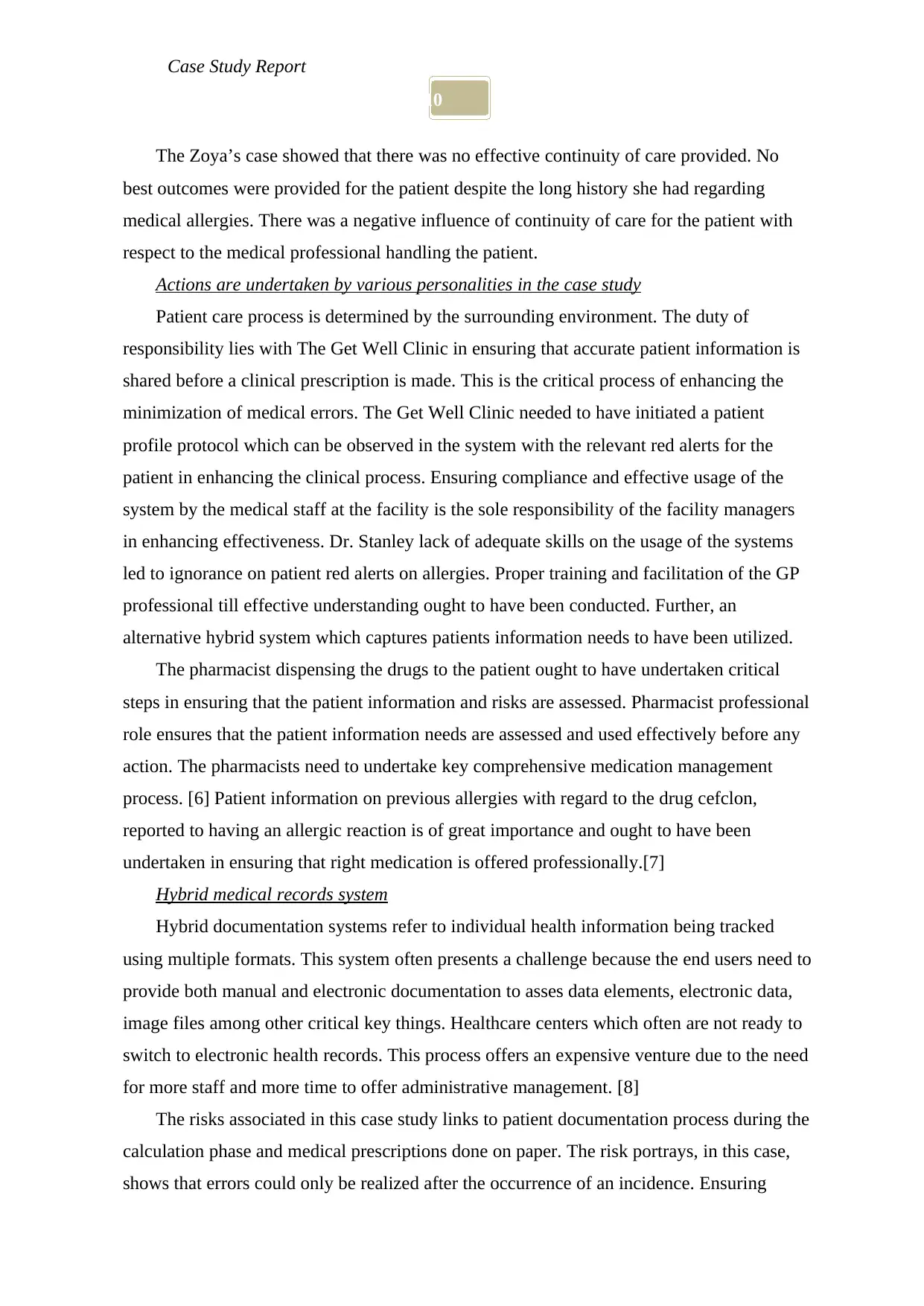
10
Case Study Report
The Zoya’s case showed that there was no effective continuity of care provided. No
best outcomes were provided for the patient despite the long history she had regarding
medical allergies. There was a negative influence of continuity of care for the patient with
respect to the medical professional handling the patient.
Actions are undertaken by various personalities in the case study
Patient care process is determined by the surrounding environment. The duty of
responsibility lies with The Get Well Clinic in ensuring that accurate patient information is
shared before a clinical prescription is made. This is the critical process of enhancing the
minimization of medical errors. The Get Well Clinic needed to have initiated a patient
profile protocol which can be observed in the system with the relevant red alerts for the
patient in enhancing the clinical process. Ensuring compliance and effective usage of the
system by the medical staff at the facility is the sole responsibility of the facility managers
in enhancing effectiveness. Dr. Stanley lack of adequate skills on the usage of the systems
led to ignorance on patient red alerts on allergies. Proper training and facilitation of the GP
professional till effective understanding ought to have been conducted. Further, an
alternative hybrid system which captures patients information needs to have been utilized.
The pharmacist dispensing the drugs to the patient ought to have undertaken critical
steps in ensuring that the patient information and risks are assessed. Pharmacist professional
role ensures that the patient information needs are assessed and used effectively before any
action. The pharmacists need to undertake key comprehensive medication management
process. [6] Patient information on previous allergies with regard to the drug cefclon,
reported to having an allergic reaction is of great importance and ought to have been
undertaken in ensuring that right medication is offered professionally.[7]
Hybrid medical records system
Hybrid documentation systems refer to individual health information being tracked
using multiple formats. This system often presents a challenge because the end users need to
provide both manual and electronic documentation to asses data elements, electronic data,
image files among other critical key things. Healthcare centers which often are not ready to
switch to electronic health records. This process offers an expensive venture due to the need
for more staff and more time to offer administrative management. [8]
The risks associated in this case study links to patient documentation process during the
calculation phase and medical prescriptions done on paper. The risk portrays, in this case,
shows that errors could only be realized after the occurrence of an incidence. Ensuring
Case Study Report
The Zoya’s case showed that there was no effective continuity of care provided. No
best outcomes were provided for the patient despite the long history she had regarding
medical allergies. There was a negative influence of continuity of care for the patient with
respect to the medical professional handling the patient.
Actions are undertaken by various personalities in the case study
Patient care process is determined by the surrounding environment. The duty of
responsibility lies with The Get Well Clinic in ensuring that accurate patient information is
shared before a clinical prescription is made. This is the critical process of enhancing the
minimization of medical errors. The Get Well Clinic needed to have initiated a patient
profile protocol which can be observed in the system with the relevant red alerts for the
patient in enhancing the clinical process. Ensuring compliance and effective usage of the
system by the medical staff at the facility is the sole responsibility of the facility managers
in enhancing effectiveness. Dr. Stanley lack of adequate skills on the usage of the systems
led to ignorance on patient red alerts on allergies. Proper training and facilitation of the GP
professional till effective understanding ought to have been conducted. Further, an
alternative hybrid system which captures patients information needs to have been utilized.
The pharmacist dispensing the drugs to the patient ought to have undertaken critical
steps in ensuring that the patient information and risks are assessed. Pharmacist professional
role ensures that the patient information needs are assessed and used effectively before any
action. The pharmacists need to undertake key comprehensive medication management
process. [6] Patient information on previous allergies with regard to the drug cefclon,
reported to having an allergic reaction is of great importance and ought to have been
undertaken in ensuring that right medication is offered professionally.[7]
Hybrid medical records system
Hybrid documentation systems refer to individual health information being tracked
using multiple formats. This system often presents a challenge because the end users need to
provide both manual and electronic documentation to asses data elements, electronic data,
image files among other critical key things. Healthcare centers which often are not ready to
switch to electronic health records. This process offers an expensive venture due to the need
for more staff and more time to offer administrative management. [8]
The risks associated in this case study links to patient documentation process during the
calculation phase and medical prescriptions done on paper. The risk portrays, in this case,
shows that errors could only be realized after the occurrence of an incidence. Ensuring
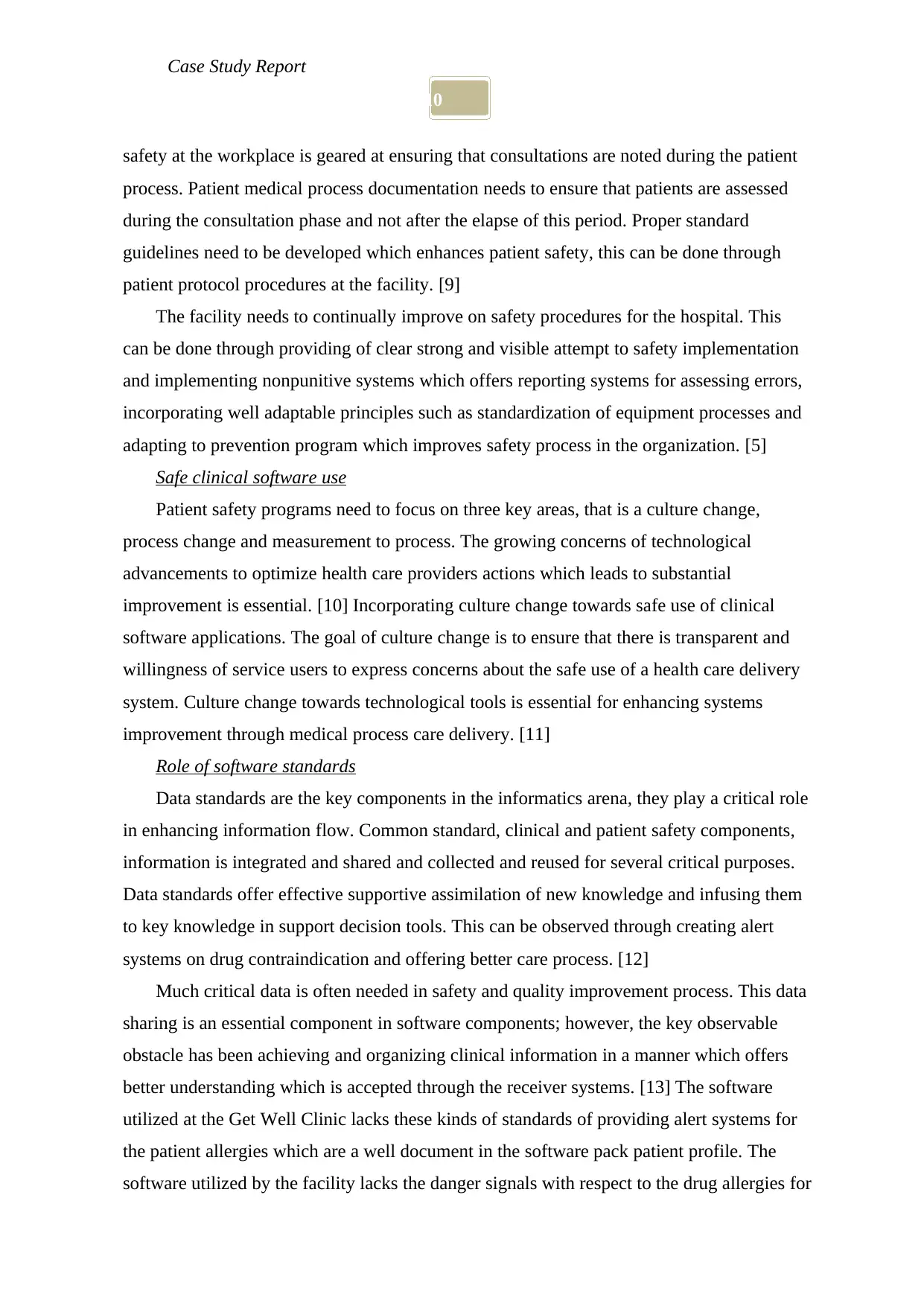
10
Case Study Report
safety at the workplace is geared at ensuring that consultations are noted during the patient
process. Patient medical process documentation needs to ensure that patients are assessed
during the consultation phase and not after the elapse of this period. Proper standard
guidelines need to be developed which enhances patient safety, this can be done through
patient protocol procedures at the facility. [9]
The facility needs to continually improve on safety procedures for the hospital. This
can be done through providing of clear strong and visible attempt to safety implementation
and implementing nonpunitive systems which offers reporting systems for assessing errors,
incorporating well adaptable principles such as standardization of equipment processes and
adapting to prevention program which improves safety process in the organization. [5]
Safe clinical software use
Patient safety programs need to focus on three key areas, that is a culture change,
process change and measurement to process. The growing concerns of technological
advancements to optimize health care providers actions which leads to substantial
improvement is essential. [10] Incorporating culture change towards safe use of clinical
software applications. The goal of culture change is to ensure that there is transparent and
willingness of service users to express concerns about the safe use of a health care delivery
system. Culture change towards technological tools is essential for enhancing systems
improvement through medical process care delivery. [11]
Role of software standards
Data standards are the key components in the informatics arena, they play a critical role
in enhancing information flow. Common standard, clinical and patient safety components,
information is integrated and shared and collected and reused for several critical purposes.
Data standards offer effective supportive assimilation of new knowledge and infusing them
to key knowledge in support decision tools. This can be observed through creating alert
systems on drug contraindication and offering better care process. [12]
Much critical data is often needed in safety and quality improvement process. This data
sharing is an essential component in software components; however, the key observable
obstacle has been achieving and organizing clinical information in a manner which offers
better understanding which is accepted through the receiver systems. [13] The software
utilized at the Get Well Clinic lacks these kinds of standards of providing alert systems for
the patient allergies which are a well document in the software pack patient profile. The
software utilized by the facility lacks the danger signals with respect to the drug allergies for
Case Study Report
safety at the workplace is geared at ensuring that consultations are noted during the patient
process. Patient medical process documentation needs to ensure that patients are assessed
during the consultation phase and not after the elapse of this period. Proper standard
guidelines need to be developed which enhances patient safety, this can be done through
patient protocol procedures at the facility. [9]
The facility needs to continually improve on safety procedures for the hospital. This
can be done through providing of clear strong and visible attempt to safety implementation
and implementing nonpunitive systems which offers reporting systems for assessing errors,
incorporating well adaptable principles such as standardization of equipment processes and
adapting to prevention program which improves safety process in the organization. [5]
Safe clinical software use
Patient safety programs need to focus on three key areas, that is a culture change,
process change and measurement to process. The growing concerns of technological
advancements to optimize health care providers actions which leads to substantial
improvement is essential. [10] Incorporating culture change towards safe use of clinical
software applications. The goal of culture change is to ensure that there is transparent and
willingness of service users to express concerns about the safe use of a health care delivery
system. Culture change towards technological tools is essential for enhancing systems
improvement through medical process care delivery. [11]
Role of software standards
Data standards are the key components in the informatics arena, they play a critical role
in enhancing information flow. Common standard, clinical and patient safety components,
information is integrated and shared and collected and reused for several critical purposes.
Data standards offer effective supportive assimilation of new knowledge and infusing them
to key knowledge in support decision tools. This can be observed through creating alert
systems on drug contraindication and offering better care process. [12]
Much critical data is often needed in safety and quality improvement process. This data
sharing is an essential component in software components; however, the key observable
obstacle has been achieving and organizing clinical information in a manner which offers
better understanding which is accepted through the receiver systems. [13] The software
utilized at the Get Well Clinic lacks these kinds of standards of providing alert systems for
the patient allergies which are a well document in the software pack patient profile. The
software utilized by the facility lacks the danger signals with respect to the drug allergies for
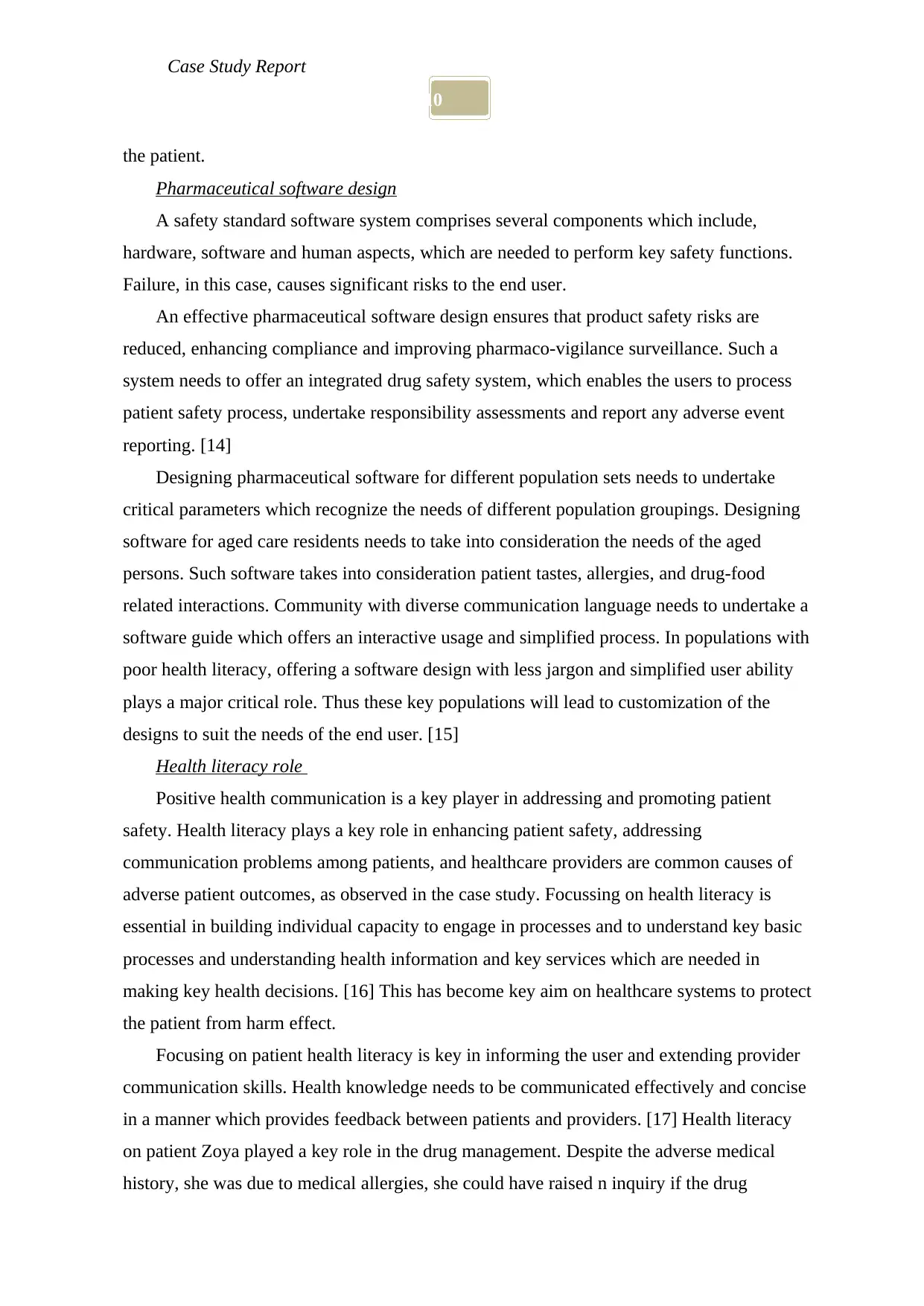
10
Case Study Report
the patient.
Pharmaceutical software design
A safety standard software system comprises several components which include,
hardware, software and human aspects, which are needed to perform key safety functions.
Failure, in this case, causes significant risks to the end user.
An effective pharmaceutical software design ensures that product safety risks are
reduced, enhancing compliance and improving pharmaco-vigilance surveillance. Such a
system needs to offer an integrated drug safety system, which enables the users to process
patient safety process, undertake responsibility assessments and report any adverse event
reporting. [14]
Designing pharmaceutical software for different population sets needs to undertake
critical parameters which recognize the needs of different population groupings. Designing
software for aged care residents needs to take into consideration the needs of the aged
persons. Such software takes into consideration patient tastes, allergies, and drug-food
related interactions. Community with diverse communication language needs to undertake a
software guide which offers an interactive usage and simplified process. In populations with
poor health literacy, offering a software design with less jargon and simplified user ability
plays a major critical role. Thus these key populations will lead to customization of the
designs to suit the needs of the end user. [15]
Health literacy role
Positive health communication is a key player in addressing and promoting patient
safety. Health literacy plays a key role in enhancing patient safety, addressing
communication problems among patients, and healthcare providers are common causes of
adverse patient outcomes, as observed in the case study. Focussing on health literacy is
essential in building individual capacity to engage in processes and to understand key basic
processes and understanding health information and key services which are needed in
making key health decisions. [16] This has become key aim on healthcare systems to protect
the patient from harm effect.
Focusing on patient health literacy is key in informing the user and extending provider
communication skills. Health knowledge needs to be communicated effectively and concise
in a manner which provides feedback between patients and providers. [17] Health literacy
on patient Zoya played a key role in the drug management. Despite the adverse medical
history, she was due to medical allergies, she could have raised n inquiry if the drug
Case Study Report
the patient.
Pharmaceutical software design
A safety standard software system comprises several components which include,
hardware, software and human aspects, which are needed to perform key safety functions.
Failure, in this case, causes significant risks to the end user.
An effective pharmaceutical software design ensures that product safety risks are
reduced, enhancing compliance and improving pharmaco-vigilance surveillance. Such a
system needs to offer an integrated drug safety system, which enables the users to process
patient safety process, undertake responsibility assessments and report any adverse event
reporting. [14]
Designing pharmaceutical software for different population sets needs to undertake
critical parameters which recognize the needs of different population groupings. Designing
software for aged care residents needs to take into consideration the needs of the aged
persons. Such software takes into consideration patient tastes, allergies, and drug-food
related interactions. Community with diverse communication language needs to undertake a
software guide which offers an interactive usage and simplified process. In populations with
poor health literacy, offering a software design with less jargon and simplified user ability
plays a major critical role. Thus these key populations will lead to customization of the
designs to suit the needs of the end user. [15]
Health literacy role
Positive health communication is a key player in addressing and promoting patient
safety. Health literacy plays a key role in enhancing patient safety, addressing
communication problems among patients, and healthcare providers are common causes of
adverse patient outcomes, as observed in the case study. Focussing on health literacy is
essential in building individual capacity to engage in processes and to understand key basic
processes and understanding health information and key services which are needed in
making key health decisions. [16] This has become key aim on healthcare systems to protect
the patient from harm effect.
Focusing on patient health literacy is key in informing the user and extending provider
communication skills. Health knowledge needs to be communicated effectively and concise
in a manner which provides feedback between patients and providers. [17] Health literacy
on patient Zoya played a key role in the drug management. Despite the adverse medical
history, she was due to medical allergies, she could have raised n inquiry if the drug
Paraphrase This Document
Need a fresh take? Get an instant paraphrase of this document with our AI Paraphraser
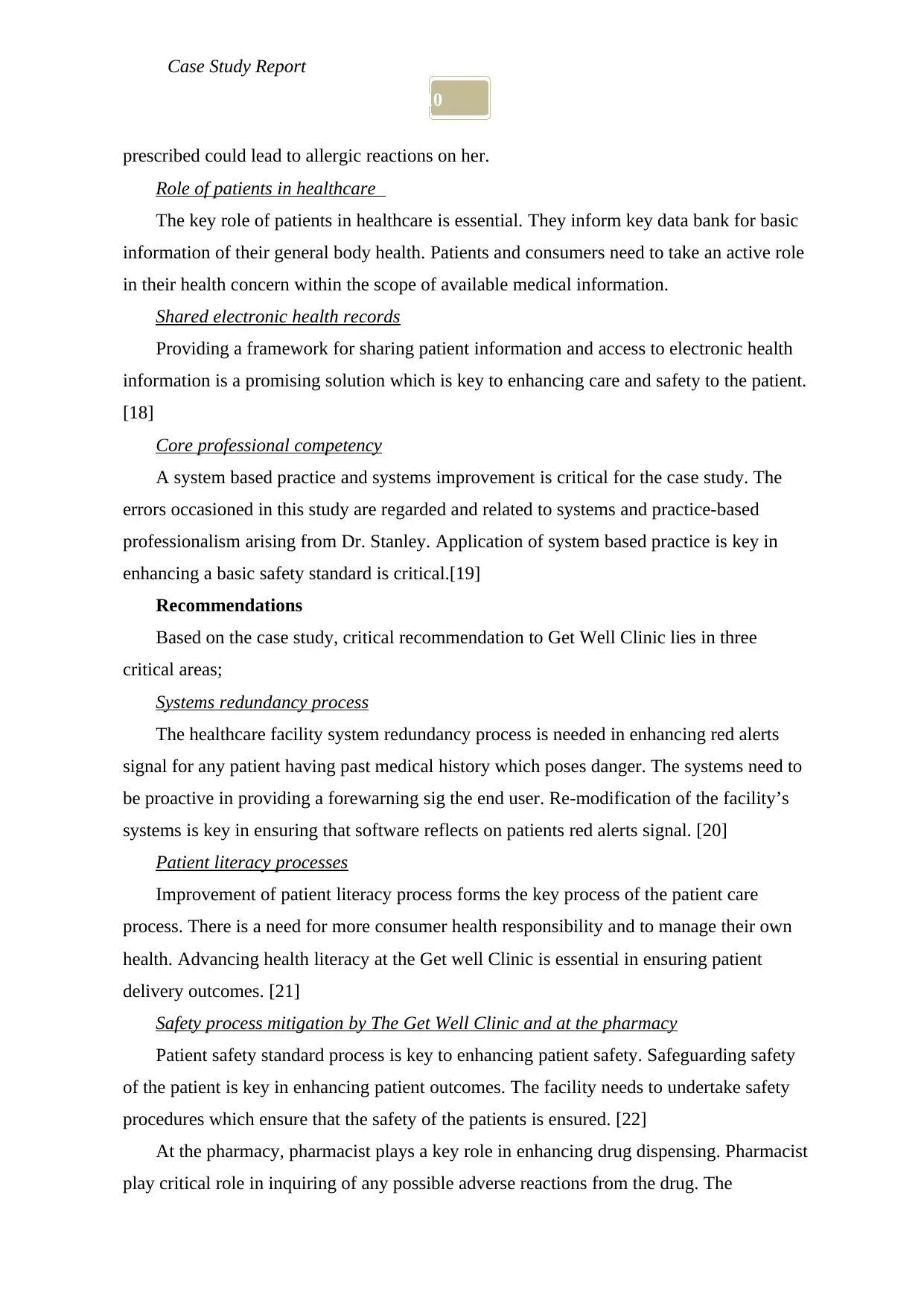
10
Case Study Report
prescribed could lead to allergic reactions on her.
Role of patients in healthcare
The key role of patients in healthcare is essential. They inform key data bank for basic
information of their general body health. Patients and consumers need to take an active role
in their health concern within the scope of available medical information.
Shared electronic health records
Providing a framework for sharing patient information and access to electronic health
information is a promising solution which is key to enhancing care and safety to the patient.
[18]
Core professional competency
A system based practice and systems improvement is critical for the case study. The
errors occasioned in this study are regarded and related to systems and practice-based
professionalism arising from Dr. Stanley. Application of system based practice is key in
enhancing a basic safety standard is critical.[19]
Recommendations
Based on the case study, critical recommendation to Get Well Clinic lies in three
critical areas;
Systems redundancy process
The healthcare facility system redundancy process is needed in enhancing red alerts
signal for any patient having past medical history which poses danger. The systems need to
be proactive in providing a forewarning sig the end user. Re-modification of the facility’s
systems is key in ensuring that software reflects on patients red alerts signal. [20]
Patient literacy processes
Improvement of patient literacy process forms the key process of the patient care
process. There is a need for more consumer health responsibility and to manage their own
health. Advancing health literacy at the Get well Clinic is essential in ensuring patient
delivery outcomes. [21]
Safety process mitigation by The Get Well Clinic and at the pharmacy
Patient safety standard process is key to enhancing patient safety. Safeguarding safety
of the patient is key in enhancing patient outcomes. The facility needs to undertake safety
procedures which ensure that the safety of the patients is ensured. [22]
At the pharmacy, pharmacist plays a key role in enhancing drug dispensing. Pharmacist
play critical role in inquiring of any possible adverse reactions from the drug. The
Case Study Report
prescribed could lead to allergic reactions on her.
Role of patients in healthcare
The key role of patients in healthcare is essential. They inform key data bank for basic
information of their general body health. Patients and consumers need to take an active role
in their health concern within the scope of available medical information.
Shared electronic health records
Providing a framework for sharing patient information and access to electronic health
information is a promising solution which is key to enhancing care and safety to the patient.
[18]
Core professional competency
A system based practice and systems improvement is critical for the case study. The
errors occasioned in this study are regarded and related to systems and practice-based
professionalism arising from Dr. Stanley. Application of system based practice is key in
enhancing a basic safety standard is critical.[19]
Recommendations
Based on the case study, critical recommendation to Get Well Clinic lies in three
critical areas;
Systems redundancy process
The healthcare facility system redundancy process is needed in enhancing red alerts
signal for any patient having past medical history which poses danger. The systems need to
be proactive in providing a forewarning sig the end user. Re-modification of the facility’s
systems is key in ensuring that software reflects on patients red alerts signal. [20]
Patient literacy processes
Improvement of patient literacy process forms the key process of the patient care
process. There is a need for more consumer health responsibility and to manage their own
health. Advancing health literacy at the Get well Clinic is essential in ensuring patient
delivery outcomes. [21]
Safety process mitigation by The Get Well Clinic and at the pharmacy
Patient safety standard process is key to enhancing patient safety. Safeguarding safety
of the patient is key in enhancing patient outcomes. The facility needs to undertake safety
procedures which ensure that the safety of the patients is ensured. [22]
At the pharmacy, pharmacist plays a key role in enhancing drug dispensing. Pharmacist
play critical role in inquiring of any possible adverse reactions from the drug. The

10
Case Study Report
pharmacist needs to play a key role and ensure that key dispensing safety process is
enhanced in drug delivery systems.
Case Study Report
pharmacist needs to play a key role and ensure that key dispensing safety process is
enhanced in drug delivery systems.

10
Case Study Report
References
1. Antibiotic Epert Group. Threpeautic guidelines:Antibiotic Version 14. Melbourne:
Thepeatic Ltd.
2. Royal Australian College of General Prcatitioners. Standards for General prcattices
(4TH ED).Available at :http//www.psa.org.au/download/standards/professional
practice-standards-vf-pdf.
3. Ong MS, Coiera E. Safety through redundancy: a case study of in-hospital patient
transfers. Qual Saf Health Care. 2010 Oct 1;19(5):e32-.
4. Saultz JW, Lochner J. Interpersonal continuity of care and care outcomes: a critical
review. The Annals of Family Medicine. 2005 Mar 1;3(2):159-66.
5. Donaldson MS, Corrigan JM, Kohn LT, editors. To err is human: building a safer
health system. National Academies Press; 2000 Apr 1.
6. American Nurses Association. The Nursing Process.
http://www.nursingworld.org/EspeciallyForYou/What-is-Nursing/Tools-You-Need/
Thenursingprocess.html. Accessed Septemebr 24, 2018.
7. Cipolle RJ, Strand LM, Morley PC. Pharmaceutical care practice: the patient-centered
approach to medication management. McGraw Hill Professional; 2012 Apr 22
8. Ludwick DA, Doucette J. Adopting electronic medical records in primary care:
lessons learned from health information systems implementation experience in seven
countries. International journal of medical informatics. 2009 Jan 1;78(1):22-31.
9. Heeks R. Health information systems: Failure, success and improvisation.
International journal of medical informatics. 2006 Feb 1;75(2):125-37.
10. Leape LL, Cullen DJ, Clapp MD, Burdick E, Demonaco HJ, Erickson JI, Bates DW.
Pharmacist participation on physician rounds and adverse drug events in the intensive
care unit. Jama. 1999 Jul 21;282(3):267-70.
11. Carroll JS, Edmondson AC. Leading organisational learning in health care. BMJ
Quality & Safety. 2002 Mar 1;11(1):51-6.
12. Brown, S. H., R. Levin, M. J. Lincoln, R. M. Kolodner, and S. J. Nelson. United
States Government Progress Towards a Common Information Infrastructure for
Medications. Bethesda, MD: National Library of Medicine, . 2003.
13. Hammond, W. E. Overview of Health Care Data Standards. Commissioned paper for
IOM Committee on Data Standards for Patient Safety, . 2002.
Case Study Report
References
1. Antibiotic Epert Group. Threpeautic guidelines:Antibiotic Version 14. Melbourne:
Thepeatic Ltd.
2. Royal Australian College of General Prcatitioners. Standards for General prcattices
(4TH ED).Available at :http//www.psa.org.au/download/standards/professional
practice-standards-vf-pdf.
3. Ong MS, Coiera E. Safety through redundancy: a case study of in-hospital patient
transfers. Qual Saf Health Care. 2010 Oct 1;19(5):e32-.
4. Saultz JW, Lochner J. Interpersonal continuity of care and care outcomes: a critical
review. The Annals of Family Medicine. 2005 Mar 1;3(2):159-66.
5. Donaldson MS, Corrigan JM, Kohn LT, editors. To err is human: building a safer
health system. National Academies Press; 2000 Apr 1.
6. American Nurses Association. The Nursing Process.
http://www.nursingworld.org/EspeciallyForYou/What-is-Nursing/Tools-You-Need/
Thenursingprocess.html. Accessed Septemebr 24, 2018.
7. Cipolle RJ, Strand LM, Morley PC. Pharmaceutical care practice: the patient-centered
approach to medication management. McGraw Hill Professional; 2012 Apr 22
8. Ludwick DA, Doucette J. Adopting electronic medical records in primary care:
lessons learned from health information systems implementation experience in seven
countries. International journal of medical informatics. 2009 Jan 1;78(1):22-31.
9. Heeks R. Health information systems: Failure, success and improvisation.
International journal of medical informatics. 2006 Feb 1;75(2):125-37.
10. Leape LL, Cullen DJ, Clapp MD, Burdick E, Demonaco HJ, Erickson JI, Bates DW.
Pharmacist participation on physician rounds and adverse drug events in the intensive
care unit. Jama. 1999 Jul 21;282(3):267-70.
11. Carroll JS, Edmondson AC. Leading organisational learning in health care. BMJ
Quality & Safety. 2002 Mar 1;11(1):51-6.
12. Brown, S. H., R. Levin, M. J. Lincoln, R. M. Kolodner, and S. J. Nelson. United
States Government Progress Towards a Common Information Infrastructure for
Medications. Bethesda, MD: National Library of Medicine, . 2003.
13. Hammond, W. E. Overview of Health Care Data Standards. Commissioned paper for
IOM Committee on Data Standards for Patient Safety, . 2002.
Secure Best Marks with AI Grader
Need help grading? Try our AI Grader for instant feedback on your assignments.
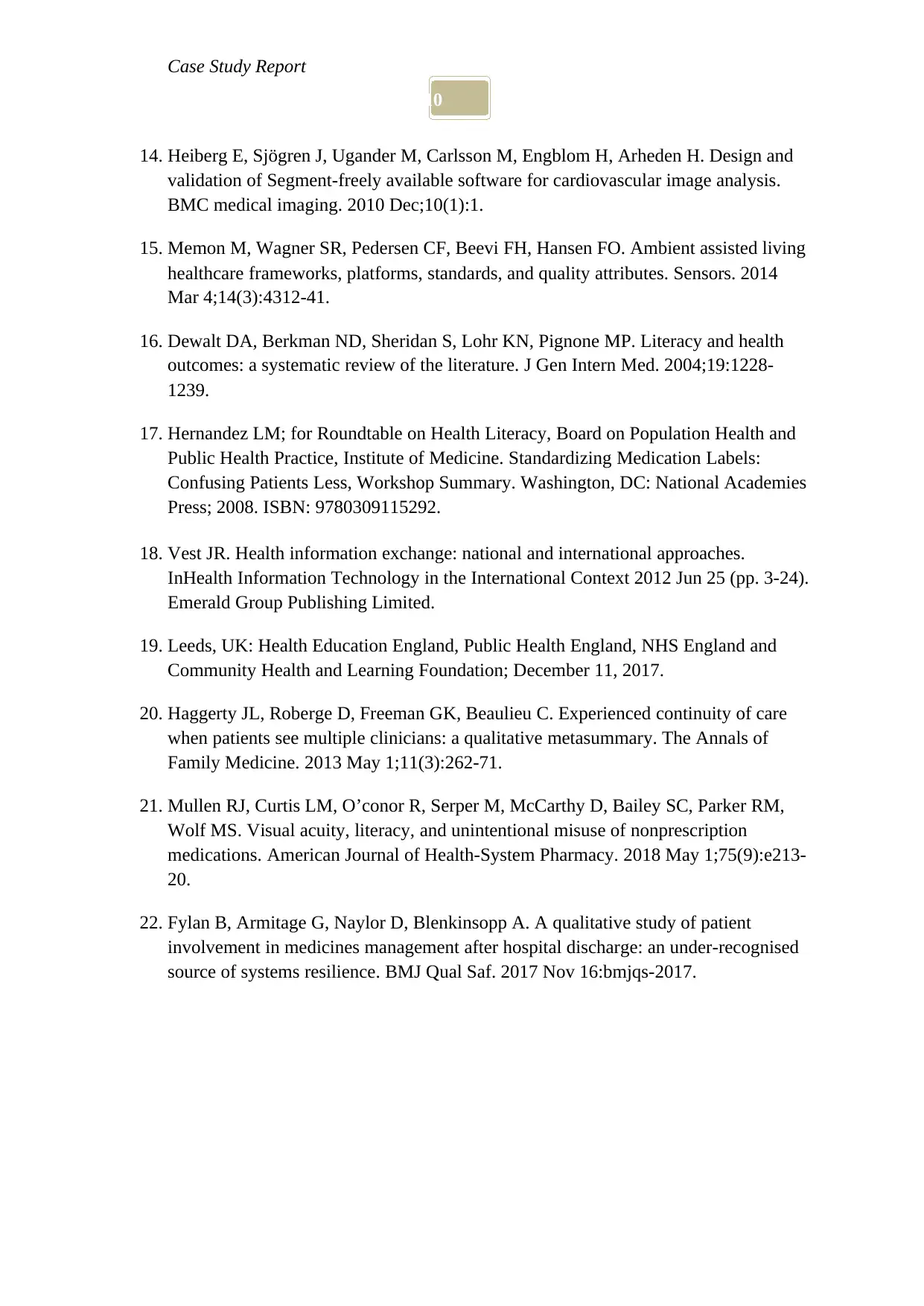
10
Case Study Report
14. Heiberg E, Sjögren J, Ugander M, Carlsson M, Engblom H, Arheden H. Design and
validation of Segment-freely available software for cardiovascular image analysis.
BMC medical imaging. 2010 Dec;10(1):1.
15. Memon M, Wagner SR, Pedersen CF, Beevi FH, Hansen FO. Ambient assisted living
healthcare frameworks, platforms, standards, and quality attributes. Sensors. 2014
Mar 4;14(3):4312-41.
16. Dewalt DA, Berkman ND, Sheridan S, Lohr KN, Pignone MP. Literacy and health
outcomes: a systematic review of the literature. J Gen Intern Med. 2004;19:1228-
1239.
17. Hernandez LM; for Roundtable on Health Literacy, Board on Population Health and
Public Health Practice, Institute of Medicine. Standardizing Medication Labels:
Confusing Patients Less, Workshop Summary. Washington, DC: National Academies
Press; 2008. ISBN: 9780309115292.
18. Vest JR. Health information exchange: national and international approaches.
InHealth Information Technology in the International Context 2012 Jun 25 (pp. 3-24).
Emerald Group Publishing Limited.
19. Leeds, UK: Health Education England, Public Health England, NHS England and
Community Health and Learning Foundation; December 11, 2017.
20. Haggerty JL, Roberge D, Freeman GK, Beaulieu C. Experienced continuity of care
when patients see multiple clinicians: a qualitative metasummary. The Annals of
Family Medicine. 2013 May 1;11(3):262-71.
21. Mullen RJ, Curtis LM, O’conor R, Serper M, McCarthy D, Bailey SC, Parker RM,
Wolf MS. Visual acuity, literacy, and unintentional misuse of nonprescription
medications. American Journal of Health-System Pharmacy. 2018 May 1;75(9):e213-
20.
22. Fylan B, Armitage G, Naylor D, Blenkinsopp A. A qualitative study of patient
involvement in medicines management after hospital discharge: an under-recognised
source of systems resilience. BMJ Qual Saf. 2017 Nov 16:bmjqs-2017.
Case Study Report
14. Heiberg E, Sjögren J, Ugander M, Carlsson M, Engblom H, Arheden H. Design and
validation of Segment-freely available software for cardiovascular image analysis.
BMC medical imaging. 2010 Dec;10(1):1.
15. Memon M, Wagner SR, Pedersen CF, Beevi FH, Hansen FO. Ambient assisted living
healthcare frameworks, platforms, standards, and quality attributes. Sensors. 2014
Mar 4;14(3):4312-41.
16. Dewalt DA, Berkman ND, Sheridan S, Lohr KN, Pignone MP. Literacy and health
outcomes: a systematic review of the literature. J Gen Intern Med. 2004;19:1228-
1239.
17. Hernandez LM; for Roundtable on Health Literacy, Board on Population Health and
Public Health Practice, Institute of Medicine. Standardizing Medication Labels:
Confusing Patients Less, Workshop Summary. Washington, DC: National Academies
Press; 2008. ISBN: 9780309115292.
18. Vest JR. Health information exchange: national and international approaches.
InHealth Information Technology in the International Context 2012 Jun 25 (pp. 3-24).
Emerald Group Publishing Limited.
19. Leeds, UK: Health Education England, Public Health England, NHS England and
Community Health and Learning Foundation; December 11, 2017.
20. Haggerty JL, Roberge D, Freeman GK, Beaulieu C. Experienced continuity of care
when patients see multiple clinicians: a qualitative metasummary. The Annals of
Family Medicine. 2013 May 1;11(3):262-71.
21. Mullen RJ, Curtis LM, O’conor R, Serper M, McCarthy D, Bailey SC, Parker RM,
Wolf MS. Visual acuity, literacy, and unintentional misuse of nonprescription
medications. American Journal of Health-System Pharmacy. 2018 May 1;75(9):e213-
20.
22. Fylan B, Armitage G, Naylor D, Blenkinsopp A. A qualitative study of patient
involvement in medicines management after hospital discharge: an under-recognised
source of systems resilience. BMJ Qual Saf. 2017 Nov 16:bmjqs-2017.

10
Case Study Report
Case Study Report
1 out of 12
Related Documents
Your All-in-One AI-Powered Toolkit for Academic Success.
+13062052269
info@desklib.com
Available 24*7 on WhatsApp / Email
![[object Object]](/_next/static/media/star-bottom.7253800d.svg)
Unlock your academic potential
© 2024 | Zucol Services PVT LTD | All rights reserved.



